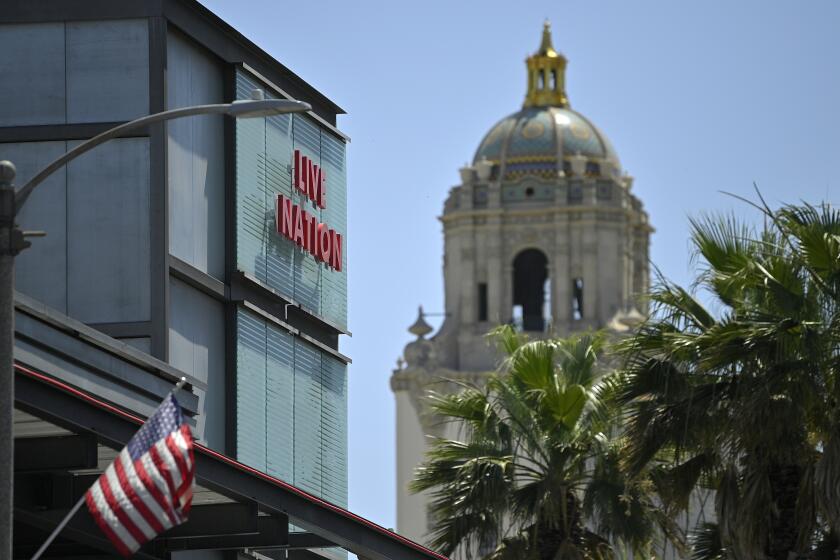L.A. County supervisors embrace LACMA’s financing plan for makeover
- Share via
The Board of Supervisors has approved a road map for the Los Angeles County Museum of Art as it plans a $600-million makeover that would tear down and rebuild most of its Miracle Mile campus, including a pledge — although not yet a binding one — to cover about 21% of the cost with county taxpayers’ money.
If there are no serious bumps in the road ahead, the plan would yield a streamlined, curving 410,000-square-foot new museum building designed by Swiss architect Peter Zumthor that would open in 2023, spanning Wilshire Boulevard with an enclosed bridge that doubles as gallery space.
Before unanimously approving the plan at their Wednesday meeting, the supervisors lauded museum Director Michael Govan’s leadership and the plan to reconfigure the museum that he’d outlined in a brief slide presentation.
“The [project] you have developed and we will be implementing is a credit to you,” said Supervisor Michael Antonovich.
“There’s nothing like embracing the future with imagination,” chimed in Mark Ridley-Thomas.
If the plan comes to fruition, all three buildings that made up LACMA’s original 1965 campus will meet the wrecking ball, along with a fourth that was added in 1986. In recent years, leaky roofs and in one case a collapsing skylight have forced the museum to close some galleries while the problems were fixed.
In his pitch for the supervisors’ support, Govan said that the older buildings “are really ailing. They are not worth saving. The new building will be much more energy efficient and accessible to a broad public.”
One of LACMA’s main selling points to the supervisors and the public is that the four aging buildings to be replaced would need an estimated $246 million to $320 million for utilities upgrades, seismic repairs, roof and flooring replacement and the like if not replaced, making a new building by the distinguished Zumthor a better value than preserving the status quo.
For Govan, who arrived at LACMA in 2006, shepherding the new building is one of the most important steps toward his long-stated goal of lifting the museum into the top tier of the nation’s “encyclopedic” museums, devoted to collecting and displaying art from all times and places. In a brief interview after getting the county’s pledge, he said he intends to remain as LACMA’s director at least long enough to see the project through to completion. “I’m here to do that. That’s my reason to be in Los Angeles.”
Instead of the current seven buildings that make up its campus, LACMA would consist of three structures dating from 2008, 2010 and 2023, plus the 1988-vintage Pavilion for Japanese Art, which is considered an architectural gem.
That does not include the former May Co. department store that LACMA has leased to the Academy of Motion Picture Arts and Sciences, which plans to renovate and add to the structure, turning it into a $300-million film museum and domed cinema.
The supervisors on Wednesday OKd a $7.5-million advance on the county’s $125 million share to fund LACMA’s next steps: commissioning more detailed design work for the new building and compiling an Environmental Impact Report.
The report, which Govan expects to take up to two years to complete, will include detailed studies laying out what’s to be built and will try to project how the new building is likely to affect its surroundings. Considerations will include traffic, parking and whether there will be any consequences for the adjacent La Brea Tar Pits, a major attraction in its own right, on which the art museum has promised not to impinge.
The public will be invited to comment on LACMA’s plan as part of the process of compiling the environmental report. If the supervisors approve the report, it will mean LACMA’s plan is a go, with the $125 million from taxpayers no longer just a pledge, but a firm commitment.
The county would then issue $125 million in municipal bonds to be paid off over 15 years, which would cover the initial phase of construction. A second bond issue totaling $300 million would follow later, technically issued by the county, but with LACMA taking sole responsibility for making all the payments over 30 years.
The other piece of the funding, $175 million, will be cash raised by LACMA. Under the new road map, the museum must secure pledges for at least that amount before construction can begin. The LACMA board has a wealthy and prominent roster that includes multibillionaire real estate magnate Donald Bren and his wife, Brigitte; philanthropist Wallis Annenberg; “American Idol” host Ryan Seacrest; and Steve Tisch, a film producer and co-owner of the National Football League’s New York Giants.
Govan said that the museum already has begun a special fundraising push aimed at raising $100 million in connection with its 50th anniversary next spring. He expects that goal to be reached by then; the money can be used for any purpose, including LACMA’s share of the construction project.
If government officials’ current predictions of future interest rates prove accurate, the total taxpayer cost for the county’s share of the bonds would come to $142.9 million over 15 years, including interest, and LACMA’s share would come to $540 million at $18 million a year for 30 years.
Govan said that LACMA will be able to remain open and active during four years of construction, mounting art shows in its two 21st century buildings, which total about 100,000 square feet of exhibition space. Those two structures were built without county funding on privately-owned land and belong to LACMA alone; the Zumthor building mainly would occupy county-owned parkland and would belong to Los Angeles County.
More to Read
The biggest entertainment stories
Get our big stories about Hollywood, film, television, music, arts, culture and more right in your inbox as soon as they publish.
You may occasionally receive promotional content from the Los Angeles Times.











